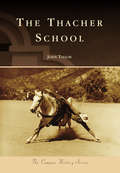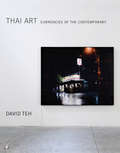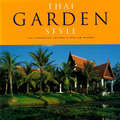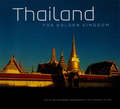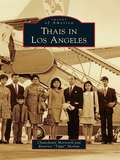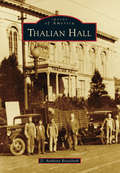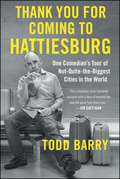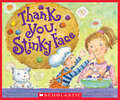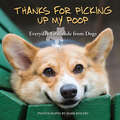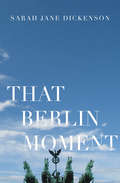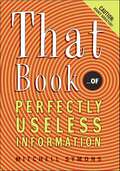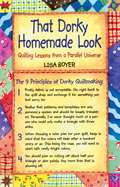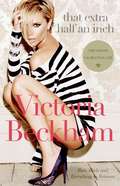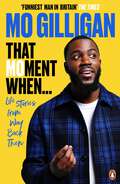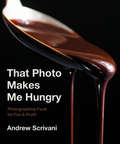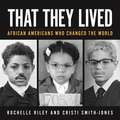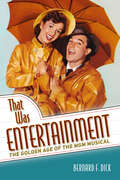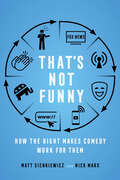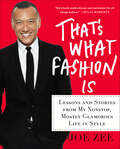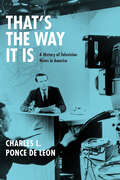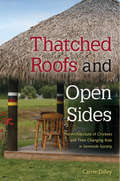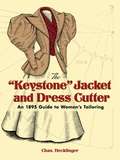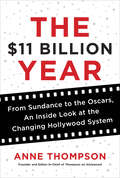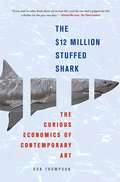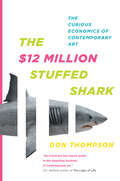- Table View
- List View
Thacher School, The
by John TaylorSherman Day Thacher, a Yale-trained lawyer, moved west in 1887, intending to join his brother as an orange rancher in California's Ojai Valley. However, after accepting a request from a Yale colleague to tutor his nephew, Thacher's focus changed from cultivating oranges to cultivating young minds. His small educational enterprise eventually became The Thacher School. Combining unmatched academics with a unique horse and camping program, Thacher has prepared more than 5,000 young men and women to become contributing members of society at the local, state, and national levels since its founding in 1889. With an educational philosophy based around Sherman Thacher's precepts of "honor, fairness, kindness, and truth," The Thacher School continues to be recognized as one of the premier secondary schools in the country.
Thai Art: Currencies of the Contemporary (The\mit Press Ser.)
by David TehThe interplay of the local and the global in contemporary Thai art, as artists strive for international recognition and a new meaning of the national.Since the 1990s, Thai contemporary art has achieved international recognition, circulating globally by way of biennials, museums, and commercial galleries. Many Thai artists have shed identification with their nation; but “Thainess” remains an interpretive crutch for understanding their work. In this book, the curator and critic David Teh examines the tension between the global and the local in Thai contemporary art. Writing the first serious study of Thai art since 1992 (and noting that art history and criticism have lagged behind the market in recognizing it), he describes the competing claims to contemporaneity, as staked in Thailand and on behalf of Thai art elsewhere. He shows how the values of the global art world are exchanged with local ones, how they do and don't correspond, and how these discrepancies have been exploited. How can we make sense of globally circulating art without forgoing the interpretive resources of the local, national, or regional context? Teh examines the work of artists who straddle the local and the global, becoming willing agents of assimilation yet resisting homogenization. He describes the transition from an artistic subjectivity couched in terms of national community to a more qualified, postnational one, against the backdrop of the singular but waning sovereignty of the Thai monarchy and sustained political and economic turmoil. Among the national currencies of Thai art that Teh identifies are an agricultural symbology, a Siamese poetics of distance and itinerancy, and Hindu-Buddhist conceptions of charismatic power. Each of these currencies has been converted to a legal tender in global art—signifying sustainability, utopia, the conceptual, and the relational—but what is lost, and what may be gained, in such exchanges?
Thai Garden Style
by Luca Invernizzi TettoniContaining over 250 photographs by world-renowned Italian photographer Luca Invernizzi Tettoni and authoritative text by gardening expert William Warren, Thai Garden Style is a unique book. Showcasing many of the finest contemporary Thai gardens in lavish colour, it contains a wealth of botanical-and other-information. Some of the gardens are in private homes, others in top international hotels and resorts, and each is a fantastic portrayal of tropical luxuriance.
Thailand: The Golden Kingdom
by Luca Invernizzi Tettoni William WarrenThis volume is a stunning visual representation of all aspects of the Thai life and culture. Author and long-term resident William Warren, provides an insightful overview of the history and geography of the kingdom, as well as a detailed exploration of the rich tradition of Thai arts and crafts, religion and cultural events. Soaking up the sun on a beach, visiting a wat, partaking in one of the numerous festivals or browsing in the art and antique shops are all part of the essentially "Thai Experience" shared here.
Thais in Los Angeles (Images of America)
by Beatrice Tippe" Morlan Chanchanit MartorellLos Angeles is home to the largest Thai population outside of Thailand. With a relatively recent history of immigration to the United States dating to 1965, reports estimate that 80,000 Thais make their home in Southern California. In spite of its brief history in the United States, the Thai community in Los Angeles has already left its mark on the city. While the proliferation of Thai-owned businesses and shops has converted East Hollywood and some San Fernando Valley neighborhoods to destinations for cultural tourism, the Thai community in Los Angeles County reverberates still from global attention over the 1995 El Monte human trafficking case. The great popularity of Thai cuisine, textiles, and cultural festivals continues to preserve, enrich, and showcase one of Asia's most distinctive cultures.
Thalian Hall
by D. Anthony RivenbarkThalian Hall is one of the oldest and most beautiful theaters in America. Forming the east wing of Wilmington's iconic city hall, this dual-purpose building has been at the center of the community's cultural and political life since it first opened in 1858. Thalian Hall is the only surviving theater designed by John Montague Trimble, one of America's foremost 19th-century theater architects. It was built at a time when Wilmington was the largest city in North Carolina. Thalian Hall is the embodiment of a tradition of performance that stretches back for over two centuries. It has hosted Shakespearean tragedies, musical concerts, and even boxing and wrestling events. For generations, Wilmington audiences have witnessed touring stars, local actors, musicians, dancers, and movies in a parade of performances and celebratory events. The story of Thalian Hall is an embroidered tapestry reflecting the history of the American theater and the community that built it.
Thank You for Coming to Hattiesburg: One Comedian's Tour of Not-Quite-the-Biggest Cities in the World
by Todd BarryFrom the veteran comedian and actor from The Wrestler and Louie comes a hilarious book of travel essays from his time on tour through secondary markets in the US, Canada, and Israel.Hello. It’s Todd Barry. Yes, the massively famous comedian. I have billions of fans all over the world, so I do my fair share of touring. While I love doing shows in the big cities (New York, Philadelphia), I also enjoy a good secondary market (Ithaca, Bethlehem). Performing in these smaller places can be great because not all entertainers stop there on tour; they don’t expect to see you. They’re appreciative. They say things like “Thank you for coming to Hattiesburg” as much as they say “Nice show.” And almost every town has their version of a hipster coffee shop, so I can get in my comfort zone. My original plan was to book one secondary market show in all fifty states, in about a year, but that idea was funnier than anything in my act. So, instead of all fifty states in a year, my agent booked multiple shows in a lot of states, plus Israel and Canada. Thank You For Coming to Hattiesburg is part tour diary, part travel guide, and part memoir (Yes, memoir. Just like the thing presidents and former child stars get to write). Follow me on my journey of small clubs, and the occasional big amphitheater. Watch me make a promoter clean the dressing room toilet in Connecticut, see me stare at beached turtles in Maui, and see how I react when Lars from Metallica shows up to see me at a rec center in Northern California. I’d love to tell you more, but I need to go book a flight to Evansville, Indiana.
Thank You, Stinky Face (Stinky Face Ser.)
by Lisa McCourtOur beloved Stinky Face is back asking Mama another timely and endearing question: Mama, are you thankful for me?In this new, original Stinky Face story, Mama tells her little one that she's thankful for him. Stinky Face, of course, has a question. With greasy, taco-covered hands and face, he asks, Mama, are you thankful for me even right now?Being thankful is a perennial theme for this young age group. Learning to appreciate yourself, the people around you, and people's unique gifts and individuality is a lesson that is more crucial now than ever, and that is what is at the heart of this touching story. Author Lisa McCourt and illustrator Cyd Moore team up once again to bring us a truly endearing tale of mother and child that's perfect for the Thanksgiving holiday but can live all year round. This new story is the closest in feel and tone to the original, and with over one and a half million copies sold of I Love You, Stinky Face, we're confident this one will truly resonate with this audience.
Thanks for Picking Up My Poop: Everyday Gratitude from Dogs
by Editors of Ulysses PressAdorable dogs paired with the hilarious, heartwarming reasons they love their weird-looking, fur-less human companions.Honorable Mention for Pets—Foreword Indies Book of the Year AwardsHave you ever considered what our precious pooches would say to us if they could speak?In Thanks for Picking Up My Poop, our cute and cuddly canine companions impart their humorous and heartfelt motivations for staying so dedicated to their sometimes-clueless caregivers.Packed with engaging photos and clever snippets of doggy wisdom, this book helps us mere humans better appreciate those moments of happiness we share with others every day.“A fun and cute present for dog lovers.” —Abilene Reporter News“Who has not lived in fear of how they will be able to waste time when their internet is down? . . . Just add this little book to your emergency supplies (next to the deck of cards). It doesn’t take up much room, and has gobs of the pictures and captions you need.” —Kennett Veterinary Clinic
That Berlin Moment
by Sarah Jane DickensonBold, challenging and compelling That Berlin Moment is a play for four adult characters, two female and two male, which explores how memory is more about the present and the future than the past. 'Why don't I feel husband? I look at you and I don't feel husband, I smell you and I don't smell husband, I look at you and I -' A tragic accident has robbed Alex of her memory. Her attentive husband is eager to fill the gaps for her. But the more he tells her the more she hates who he tells her she is. Determined not to remember at all costs and with the help of a young doctor with a head full of maverick theories and a very new stethoscope, she agrees to meet the mysterious fellow patient, Stranger. Together they begin to explore and enjoy the present, but it soon becomes clear that his memories won't stay forgotten with terrifying consequences for both them and the Doctor.
That Book: ...of Perfectly Useless Information
by Mitchell SymonsDid you know that . . .John Wayne once won the dog Lassie from its owner in a poker game?Hijinks is the only word in the English language with three dotted letters in a row?The shortest war in history, between England and Zanzibar in 1896, lasted only thirty-eight minutes?Want to learn which U.S. president was a descendant of King Edward III? Or which famous people lived to read their own obituaries? Then That Book is the book for you! From history to science to pop culture, here is an irresistible, enlightening, and absolutely addictive treasure trove of fascinating and fun little-known facts that no one needs to know—an indispensable boon to every true lover of trivia and marvelous minutia!
That Dorky Homemade Look: Quilting Lessons From A Parallel Universe
by Lisa BoyerFed up with feeling like you can't meet the standards of the Quilt Police? Do you want to quilt for comfort and pleasure -- and not to win some high-falutin' quilting contest? Weary of worrying about what others will think of your color choices -- or your pieced points? Or your applique stitches? That Dorky Homemade Look: Quilting Lessons from a Parallel Universe is the quilting companion you've been wishing for. Lisa Boyer, a popular columnist for Quilting Today magazine, gives you permission to quilt because you love it. She clears your path of all those merciless judgments pronounced by the Quilting Queens. She invites you to make quilts that are full of life. This funny book offers these nine principles for the 20 million quilters in America: 1. Pretty fabric is not acceptable. Go right back to the quilt shop and exchange it for something you feel sorry for. 2. Realize that patterns and templates are only someone's opinion and should be loosely translated. Personally, I've never thought much of a person who could only make a triangle with three sides. 3. When choosing a color plan for your quilt, keep in mind that the colors will fade after a hundred years or so. This being the case, you will need to start with really bright colors. 4. You should plan on cutting off about half your triangle or star points. Any more than that is showing off. 5. If you are doing applique, remember that bigger is dorkier. Flowers should be huge. Animals should possess really big eyes. 6. Throw away your seam ripper and repeat after me: "Oops. Oh, no one will notice." 7. Plan on running out of border fabric when you are three-quarters of the way finished. Complete the remaining border with something else you have a lot of, preferably in an unrelated color family. 8. You should be able to quilt equally well in all directions. I had to really work on this one. It was difficult to make my forward stitching look as bad as my backward stitching, but closing my eyes helped. 9. When you have put your last stitch in the binding, you are still only half finished. Your quilt must now undergo a thorough conditioning. Give it to someone you love dearly-to drag around the house, wrap up in, spill something on, and wash and dry until it is properly lumpy. "No reason not to have quiltmaking be a pleasure", says Lisa Boyer, who has as firm a grip on her sense of humor as she does on her quilting needles. "If we didn't make Dorky Homemade quilts, all the quilts in the world would end up in the Beautiful Quilt Museum, untouched and intact. Quilts would just be something to look at. We would forget that quilts are lovable, touchable, shreddable, squeezable, chewable, and huggable -- made to wrap up in when the world seems to be falling down around us."
That Extra Half An Inch: Hair, Heels and Everything in Between
by Victoria BeckhamI've always been a girls' girl. And I know from experience that making the very best of yourself is something any woman can do. I was never the six-foot-tall pin-up. I've always been the girl-next-door who got lucky. I've come a long way in the last ten years, but this book isn't my attempt to tell you what or what not to do. It's just to share some of what I've learned. In That Extra Half an Inch, a tongue-in-cheek reference to her love of high heels, Beckham shares her tips for finding your own style including: Learning how to dress for special occasions; Shopping for everyday wear and where to look for it; Accessories: defining the looks that work best for you; Helpful hints for the holidays; Making the most of your wardrobe; How to feel confident and look great every time you leave the house. That Extra Half an Inch is a beautiful, nothing-but-the truth, easy-to-use book on fashion, beauty and style. Victoria shares her personal style secrets so whether you're getting ready for work, a night out on the town or even doing the school run, you too can feel confident and look great every time you step out of the front door.
That Moment When: Life Stories from Way Back Then
by Mo GilliganCome on my journey. Look at where man's come from. I was working in retail in 2017.You might know Mo as the critically acclaimed stand-up comedian, BAFTA-winning presenter, Masked Singer judge and social media mega star. But do you know the moments that really made him? Opening up on the turning points, the good times, the challenges and the lessons learned, this is Mo as you've never seen him before.Journeying through childhood memories in South London, Mo reminisces about school days and old-school raving, and takes us behind the scenes of his first comedy gigs, the creation of the original Geezer, selling out national tours and becoming one of TV's most in-demand stars. Share the moment that Mo decided he wanted to be a comedian, the moment he went viral, the moment he realised he was famous (and how to deal with it), the moment his Netflix special dropped, the moment he won his BAFTA and the moments he still has to come.In among the laugh-out-loud observations, life lessons and candid storytelling, there lies the bigger influences in Mo's life - the unsung heroes of the Black British comedy scene, the power of community and the feel-good legacy he wants to create.'The Funniest Man in Britain' The Times
That Photo Makes Me Hungry: Photographing Food For Fun And Profit
by Andrew ScrivaniDiscover insider secrets for mouthwatering photographs Andrew Scrivani, food photographer for the New York Times, is one of the most respected names in the business. He’s also a teacher of the craft, advising #foodporn obsessives, bloggers, photographers ready for the next step, and anyone who loves to shoot and eat, in how to: See the light (craft and shape it the way you want) Embrace the math (calculate ISO, aperture, shutter speed, and white balance) Consider visual storytelling (single vs. multiple image narratives) Master tricks for shooting in restaurants (window, bounce cards) Be a control freak (shop, prep, cook, style, and shoot) Turn passion into profit (work and get paid) Part straight-forward practical advice, part stories from the field, with many of Scrivani’s signature photos, this book will definitely make you hungry.
That They Lived: African Americans Who Changed the World (Painted Turtle)
by Rochelle Riley Cristi Smith-JonesIn February 2017, Rochelle Riley was reading Twitter posts and came across a series of black-and-white photos of four-year-old Lola dressed up as different African American women who had made history. Rochelle was immediately smitten. She was so proud to see this little girl so powerfully honor the struggle and achievement of women several decades her senior. Rochelle reached out to Lola’s mom, Cristi Smith-Jones, and asked to pair her writing with Smith-Jones’s incredible photographs for a book. The goal? To teach children on the cusp of puberty that they could be anything they aspired to be, that every famous person was once a child who, in some cases, overcame great obstacles to achieve. That They Lived: African Americans Who Changed the World features Riley’s grandson, Caleb, and Lola photographed in timeless black and white, dressed as important individuals such as business owners, educators, civil rights leaders, and artists, alongside detailed biographies that begin with the figures as young children who had the same ambitions, fears, strengths, and obstacles facing them that readers today may still experience. Muhammad Ali’s bike was stolen when he was twelve years old and the police officer he reported the crime to suggested he learn how to fight before he caught up with the thief. Bessie Coleman, the first African American female aviator, collected and washed her neighbors’ dirty laundry so she could raise enough money for college. When Duke Ellington was seven years old, he preferred playing baseball to attending the piano lessons his mom had arranged. That They Lived fills in gaps in the history that American children have been taught for generations. For African American children, it will prove that they are more than descendants of the enslaved. For all children, it will show that every child can achieve great things and work together to make the world a better place for all. That They Lived was made possible through a grant provided by the Community Foundation for Southeast Michigan.
That Was Entertainment: The Golden Age of the MGM Musical
by Bernard F. DickThat Was Entertainment: The Golden Age of the MGM Musical traces the development of the MGM musical from The Broadway Melody (1929) through its heyday in the 1940s and 1950s and its decline in the 1960s, culminating in the notorious 1970 MGM auction when Judy Garland's ruby slippers from The Wizard of Oz, Charlton Heston's chariot from Ben-Hur, and Fred Astaire's trousers and dress shirt from Royal Wedding vanished to the highest bidders.That Was Entertainment uniquely reconstructs the life of Arthur Freed, whose unit at MGM became the gold standard against which the musicals of other studios were measured. Without Freed, Judy Garland, Gene Kelly, Fred Astaire, Ann Miller, Betty Garrett, Cyd Charisse, Arlene Dahl, Vera-Ellen, Lucille Bremer, Gloria DeHaven, Howard Keel, and June Allyson would never have had the signature films that established them as movie legends.MGM's past is its present. No other studio produced such a range of musicals that are still shown today on television and all of which are covered in this volume, from integrated musicals in which song and dance were seamlessly embedded in the plot (Meet Me in St. Louis and Seven Brides for Seven Brothers) to revues (The Hollywood Revue of 1929 and Ziegfeld Follies); original musicals (Singin' in the Rain, Easter Parade, and It's Always Fair Weather); adaptations of Broadway shows (Girl Crazy, On the Town, Show Boat, Kiss Me Kate, Brigadoon, Kismet, and Bells Are Ringing); musical versions of novels and plays (Gigi, The Pirate, and Summer Holiday); operettas (the films of Jeanette MacDonald and Nelson Eddy); mythico-historical biographies of composers (Johann Strauss Jr. in The Great Waltz and Sigmund Romberg in Deep in My Heart); and musicals featuring songwriting teams (Rodgers and Hart in Words and Music and Kalmar and Ruby in Three Little Words), opera stars (Enrico Caruso in The Great Caruso and Marjorie Lawrence in Interrupted Melody), and pop singers (Ruth Etting in Love Me or Leave Me). Also covered is the water ballet musical--in a class by itself--with Esther Williams starring as MGM's resident mermaid. This is a book for longtime lovers of the movie musical and those discovering the genre for the first time.
That's Not Funny: How the Right Makes Comedy Work for Them
by Matt SienkiewiczA rousing call for liberals and progressives to pay attention to the emergence of right-wing comedy and the political power of humor. "Why do conservatives hate comedy? Why is there no right-wing Jon Stewart?" These sorts of questions launch a million tweets, a thousand op-eds, and more than a few scholarly analyses. That's Not Funny argues that it is both an intellectual and politically strategic mistake to assume that comedy has a liberal bias. Matt Sienkiewicz and Nick Marx take readers––particularly self-described liberals––on a tour of contemporary conservative comedy and the "right-wing comedy complex." In That's Not Funny, "complex" takes on an important double meaning. On the one hand, liberals have developed a social-psychological complex—it feels difficult, even dangerous, to acknowledge that their political opposition can produce comedy. At the same time, the right has been slowly building up a comedy-industrial complex, utilizing the humorous, irony-laden media strategies of liberals such as Jon Stewart, Samantha Bee, and John Oliver to garner audiences and supporters. Right-wing comedy has been hiding in plain sight, finding its way into mainstream conservative media through figures ranging from Fox News's Greg Gutfeld to libertarian podcasters like Joe Rogan. That's Not Funny taps interviews with conservative comedians and observations of them in action to guide readers through media history, text, and technique. You will find many of these comedians utterly appalling, some surprisingly funny, and others just plain weird. They are all, however, culturally and politically relevant—the American right is attempting to seize spaces of comedy and irony previously held firmly by the left. You might not like this brand of humor, but you can't ignore it.
That's What Fashion Is: Lessons and Stories from My Nonstop, Mostly Glamorous Life in Style
by Joe ZeeJoe Zee, the Editor in Chief of Yahoo Style, former creative director of ELLE magazine, and co-host of the new ABC talk show FAB Life, takes readers behind the scenes of the crazy and wonderful world of fashion in That's What Fashion Is, packed with never-before-seen color photographs from Joe's personal collection. From his early years styling shoots for Vanity Fair's "Hollywood" issue with famed photographer Annie Leibovitz to his role playing himself on MTV's reality show The City to making celebrities look fabulous in the pages of ELLE and reporting live from the red carpet. Joe lets readers in on how the fashion industry really works, from the fashion disasters to the blockbuster successes. How do you shoot an entire magazine spread in Paris in 24 hours? What's a stylist to do when he receives a panicked call from a dress-less Cameron Diaz on Oscar day? And how do they make those celebrities look so great in the magazines? These first-person stories are combined with accessible and practical tips for women everywhere, including what to wear on your first day of work, how to take a great selfie, and how to look amazing at any age. For the first time, this ultimate fashion insider lets readers in on tales, tricks, and tips previously known only to the fashion elite in this funny and frank book.
That's the Way It Is: A History of Television News in America
by Charles L. Ponce de LeonWhen critics decry the current state of our public discourse, one reliably easy target is television news. It s too dumbed-down, they say; it s no longer news but entertainment, celebrity-obsessed and vapid. The critics may be right. But, as Charles L. Ponce de Leon explains in "That s the Way It Is," TV news has "always" walked a fine line between hard news and fluff. The familiar story of decline fails to acknowledge real changes in the media and Americans news-consuming habits, while also harking back to a golden age that, on closer examination, is revealed to be not so golden after all. Ponce de Leon traces the entire history of televised news, from the household names of the late 1940s and early 50s, like Eric Sevareid, Edward R. Murrow, and Walter Cronkite, through the rise of cable, the political power of Fox News, and the satirical punch of Colbert and Stewart. He shows us an industry forever in transition, where newsmagazines and celebrity profiles vie with political news and serious investigations. The need for ratings success and the lighter, human interest stories that can help bring it Ponce de Leon makes clear, has always sat uneasily alongside a real desire to report hard news. Highlighting the contradictions and paradoxes at the heart of TV news, and telling a story rich in familiar figures and fascinating anecdotes, "That s the Way It Is" will be the definitive account of how television has showed us our history as it happens. "
Thatched Roofs and Open Sides: The Architecture of Chickees and Their Changing Role in Seminole Society
by Carrie DilleySoutheast Chapter of the Society of Architectural Historians Award of Excellence for a Book In Thatched Roofs and Open Sides, Carrie Dilley reveals the design, construction, history, and cultural significance of the chickee, the unique Seminole structure made of palmetto and cypress. Dilley illustrates how the multipurpose structure has developed over time to meet the changing needs of the Seminole Tribe.
The "Keystone" Jacket and Dress Cutter: An 1895 Guide to Women's Tailoring
by Chas HecklingerAs the 20th century dawned, women began to abandon frilly fashions for sharply tailored suits. Professional tailors of the time turned to this comprehensive resource to create office outfits, riding pants, blouses, and other garments. Filled with more than 80 patterns, it's an invaluable reference for costume designers and fashion historians. 92 black-and-white illustrations.
The $11 Billion Year: From Sundance to the Oscars, an Inside Look at the Changing Hollywood System
by Anne Thompson"This chronicle of 2012 is a slice of what happened during a watershed year for the Hollywood movie industry. It's not the whole story, but it's a mosaic of what went on, and why, and of where things are heading."What changed in one Hollywood year to produce a record-breaking box office after two years of decline? How can the Sundance Festival influence a film's fate, as it did for Beasts of the Southern Wild and Searching for Sugar Man, which both went all the way to the Oscars? Why did John Carter misfire and The Hunger Games succeed? How did maneuvers at festivals such as South by Southwest (SXSW), Cannes, Telluride, Toronto, and New York and at conventions such as CinemaCon and Comic-Con benefit Amour, Django Unchained, Moonrise Kingdom, Silver Linings Playbook, Les Misérables, The Life of Pi, The Avengers, Lincoln, and Argo? What jeopardized Zero Dark Thirty's launch? What role does gender bias still play in the industry? What are the ten things that changed the 2012 Oscar race?When it comes to film, Anne Thompson, a seasoned reporter and critic, addresses these questions and more on her respected daily blog, Thompson on Hollywood. Each year, she observes the Hollywood machine at work: the indies at Sundance, the exhibitors' jockeying at CinemaCon, the international scene at Cannes, the summer tentpoles, the fall's "smart" films and festivals, the family-friendly and big films of the holiday season, and the glamour of the Oscars®. Inspired by William Goldman's classic book The Season, which examined the overall Broadway scene through a production-by-production analysis of one theatrical season, Thompson had long wanted to apply a similar lens to the movie business. When she chose 2012 as "the year" to track, she knew that box-office and DVD sales were declining, production costs were soaring, and the digital revolution was making big waves, but she had no idea that events would converge to bring radical structural movement, record-setting box-office revenues, and what she calls "sublime moviemaking."Though impossible to mention all 670-plus films released in 2012, Thompson includes many in this book, while focusing on the nine Best Picture nominees and the personalities and powers behind them. Reflecting on the year, Thompson concludes, "The best movies get made because filmmakers, financiers, champions, and a great many gifted creative people stubbornly ignore the obstacles. The question going forward is how adaptive these people are, and how flexible is the industry itself?"
The $12 Million Stuffed Shark: The Curious Economics of Contemporary Art
by Don ThompsonWhy would a smart New York investment banker pay $12 million for the decaying, stuffed carcass of a shark? By what alchemy does Jackson Pollock's drip painting No. 5, 1948 sell for $140 million? Intriguing and entertaining, The $12 Million Stuffed Shark is a Freakonomics approach to the economics and psychology of the contemporary art world. Why were record prices achieved at auction for works by 131 contemporary artists in 2006 alone, with astonishing new heights reached in 2007? Don Thompson explores the money, lust, and self-aggrandizement of the art world in an attempt to determine what makes a particular work valuable while others are ignored. This book is the first to look at the economics and the marketing strategies that enable the modern art market to generate such astronomical prices. Drawing on interviews with both past and present executives of auction houses and art dealerships, artists, and the buyers who move the market, Thompson launches the reader on a journey of discovery through the peculiar world of modern art. Surprising, passionate, gossipy, revelatory, The $12 Million Stuffed Shark reveals a great deal that even experienced auction purchasers do not know.
The $12 Million Stuffed Shark: The Curious Economics of Contemporary Art
by Don ThompsonThe $12 Million Stuffed Shark delves into the economics and psychology of the contemporary art world – artists, dealers, auction houses, and wealthy collectors. If it’s true – as so often said – that 85 percent of new contemporary art is bad, why were record prices achieved at auction for works by 131 contemporary artists in 2006 alone, with astonishing new heights reached in 2007? The $12 Million Stuffed Shark explores money, lust, and the self-aggrandizement of possession in an attempt to determine what makes a particular work of art valuable while others are ignored. In the style of the bestselling Freakonomics, Thompson uses economic concepts to explain the unique practices employed, to great success, in the international contemporary art market. He discusses branding and marketing and how various strategies are tailored to a wealthy clientele, driving a "must-have" culture. Drawing on exclusive interviews with both past and present executives of auction houses and art dealerships, artists, and the buyers who move the market, Thompson launches the reader on a surprising journey of discovery.
